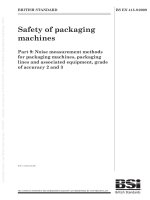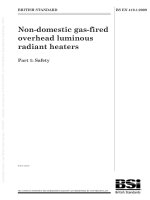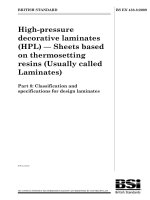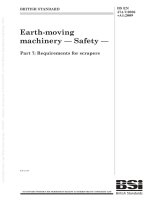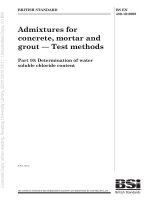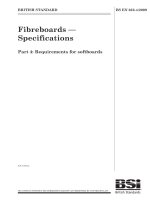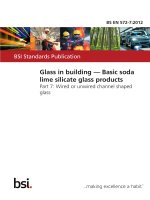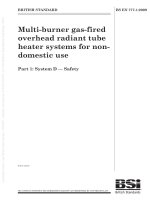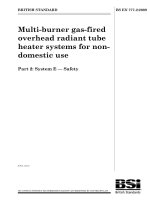Bsi bs en 61188 7 2009
Bạn đang xem bản rút gọn của tài liệu. Xem và tải ngay bản đầy đủ của tài liệu tại đây (2.22 MB, 24 trang )
BS EN 61188-7:2009
BSI British Standards
Printed boards and printed board
assemblies – Design and use —
Part 7: Electronic component zero orientation for CAD
library construction
NO COPYING WITHOUT BSI PERMISSION EXCEPT AS PERMITTED BY COPYRIGHT LAW
raising standards worldwide™
BRITISH STANDARD
BS EN 61188-7:2009
National foreword
This British Standard is the UK implementation of EN 61188-7:2009. It is
identical to IEC 61188-7:2009.
The UK participation in its preparation was entrusted to Technical Committee
EPL/501, Electronic assembly technology.
A list of organizations represented on this committee can be obtained on
request to its secretary.
This publication does not purport to include all the necessary provisions of a
contract. Users are responsible for its correct application.
© BSI 2009
ISBN 978 0 580 59866 1
ICS 31.180
Compliance with a British Standard cannot confer immunity from
legal obligations.
This British Standard was published under the authority of the Standards
Policy and Strategy Committee on 30 September 2009
Amendments issued since publication
Amd. No.
Date
Text affected
BS EN 61188-7:2009
EUROPEAN STANDARD
EN 61188-7
NORME EUROPÉENNE
July 2009
EUROPÄISCHE NORM
ICS 31.180
English version
Printed boards and printed board assemblies Design and use Part 7: Electronic component zero orientation
for CAD library construction
(IEC 61188-7:2009)
Cartes imprimées
et cartes imprimées équipées Conception et utilisation Partie 7: Orientation nulle des composants
électroniques pour l'élaboration
de la bibliothèque CAO
(CEI 61188-7:2009)
Leiterplatten und Flachbaugruppen Konstruktion und Anwendung Teil 7: Nullorientierung elektronischer
Bauelemente für CAD-Bibliotheksaufbau
(IEC 61188-7:2009)
This European Standard was approved by CENELEC on 2009-06-01. CENELEC members are bound to comply
with the CEN/CENELEC Internal Regulations which stipulate the conditions for giving this European Standard
the status of a national standard without any alteration.
Up-to-date lists and bibliographical references concerning such national standards may be obtained on
application to the Central Secretariat or to any CENELEC member.
This European Standard exists in three official versions (English, French, German). A version in any other
language made by translation under the responsibility of a CENELEC member into its own language and notified
to the Central Secretariat has the same status as the official versions.
CENELEC members are the national electrotechnical committees of Austria, Belgium, Bulgaria, Cyprus, the
Czech Republic, Denmark, Estonia, Finland, France, Germany, Greece, Hungary, Iceland, Ireland, Italy, Latvia,
Lithuania, Luxembourg, Malta, the Netherlands, Norway, Poland, Portugal, Romania, Slovakia, Slovenia, Spain,
Sweden, Switzerland and the United Kingdom.
CENELEC
European Committee for Electrotechnical Standardization
Comité Européen de Normalisation Electrotechnique
Europäisches Komitee für Elektrotechnische Normung
Central Secretariat: Avenue Marnix 17, B - 1000 Brussels
© 2009 CENELEC -
All rights of exploitation in any form and by any means reserved worldwide for CENELEC members.
Ref. No. EN 61188-7:2009 E
BS EN 61188-7:2009
EN 61188-7:2009
-2-
Foreword
The text of document 91/854/FDIS, future edition 1 of IEC 61188-7, prepared by IEC TC 91, Electronics
assembly technology, was submitted to the IEC-CENELEC parallel vote and was approved by CENELEC
as EN 61188-7 on 2009-06-01.
The following dates were fixed:
– latest date by which the EN has to be implemented
at national level by publication of an identical
national standard or by endorsement
(dop)
2010-03-01
– latest date by which the national standards conflicting
with the EN have to be withdrawn
(dow)
2012-06-01
Annex ZA has been added by CENELEC.
__________
Endorsement notice
The text of the International Standard IEC 61188-7:2009 was approved by CENELEC as a European
Standard without any modification.
__________
BS EN 61188-7:2009
EN 61188-7:2009
-3-
Annex ZA
(normative)
Normative references to international publications
with their corresponding European publications
The following referenced documents are indispensable for the application of this document. For dated
references, only the edition cited applies. For undated references, the latest edition of the referenced
document (including any amendments) applies.
NOTE When an international publication has been modified by common modifications, indicated by (mod), the relevant EN/HD
applies.
Publication
Year
Title
EN/HD
Year
Printed board assembly products Manufacturing description data and transfer
methodology Part 2: Generic requirements
-
-
IEC 61182-2
-
1)
IEC 61188-5-1
-
1)
Printed boards and printed board assemblies - EN 61188-5-1
Design and use Part 5-1: Attachment (land/joint)
considerations - Generic requirements
2002
2)
IEC 61188-5-2
-
1)
Printed boards and printed board assemblies - EN 61188-5-2
Design and use Part 5-2: Attachment (land/joint)
considerations - Discrete components
2003
2)
IEC 61188-5-3
-
1)
Printed boards and printed board assemblies - EN 61188-5-3
Design and use Part 5-3: Attachment (land/joint)
considerations - Components with gull-wing
leads on two sides
2007
2)
IEC 61188-5-4
-
1)
Printed boards and printed board assemblies - EN 61188-5-4
Design and use Part 5-4: Attachment (land/joint)
consideration - Components with J-leads on
two sides
2007
2)
IEC 61188-5-5
-
1)
Printed boards and printed board assemblies - EN 61188-5-5
Design and use Part 5-5: Attachment (land/joint)
considerations - Components with gull-wing
leads on four sides
2007
2)
IEC 61188-5-6
-
1)
Printed boards and printed board assemblies - EN 61188-5-6
Design and use Part 5-6: Attachment (land/joint)
considerations - Chip carriers with J-leads on
four sides
2003
2)
IEC 61188-5-8
-
1)
Printed boards and printed board assemblies - EN 61188-5-8
Design and use Part 5-8: Attachment (land/joint)
considerations - Area array components
(BGA, FBGA, CGA, LGA)
2008
2)
1)
Undated reference.
2)
Valid edition at date of issue.
BS EN 61188-7:2009
–2–
61188-7 © IEC:2009(E)
CONTENTS
FOREWORD...........................................................................................................................3
INTRODUCTION.....................................................................................................................5
1
Scope ...............................................................................................................................6
2
Normative references .......................................................................................................6
3
Basic rules .......................................................................................................................6
4
3.1 Common rules .........................................................................................................6
3.2 General basic rules .................................................................................................7
3.3 Level A basic rule ....................................................................................................7
3.4 Level B basic rules ..................................................................................................7
3.5 File description definition.........................................................................................7
3.6 Component orientations ..........................................................................................8
Origin point of land-pattern ............................................................................................. 16
5
4.1
4.2
4.3
Land
6
Components with one terminal........................................................................................ 18
6.1
6.2
General ................................................................................................................. 16
Surface mount components ................................................................................... 16
Through-hole leaded components.......................................................................... 17
pattern to foot print comparison ............................................................................. 18
Surface mount components ................................................................................... 18
Through-hole leaded components.......................................................................... 18
Figure 1 – Example of Level A orientation concepts ................................................................ 8
Figure 2 – Connector and switch library symbol examples .................................................... 17
Figure 3 – Through-hole components with terminal point of origin orientation ....................... 17
Figure 4 – Circular or square one terminal component .......................................................... 18
Figure 5 – Rectangular or oval one terminal component........................................................ 18
Figure 6 – Surface mount components with one lead offset................................................... 18
Table 1 – Discrete component land pattern conventions ......................................................... 9
Table 2 – Diode and transistor land pattern conventions ....................................................... 10
Table 3 – Transistor and IC land pattern conventions ........................................................... 11
Table 4 – Integrated circuit packages land pattern conventions ............................................ 12
Table 5 – Integrated circuit packages land pattern conventions ............................................ 13
Table 6 – BGA land pattern conventions ............................................................................... 14
Table 7 – Resistor array and connector land pattern conventions ......................................... 15
Table 8 – Level A land pattern convention summary ............................................................. 15
Table 9 – Level B land pattern convention summary ............................................................. 16
BS EN 61188-7:2009
61188-7 © IEC:2009(E)
–3–
INTERNATIONAL ELECTROTECHNICAL COMMISSION
____________
PRINTED BOARDS AND PRINTED BOARD ASSEMBLIES –
DESIGN AND USE –
Part 7: Electronic component zero orientation
for CAD library construction
FOREWORD
1) The International Electrotechnical Commission (IEC) is a worldwide organization for standardization comprising
all national electrotechnical committees (IEC National Committees). The object of IEC is to promote
international co-operation on all questions concerning standardization in the electrical and electronic fields. To
this end and in addition to other activities, IEC publishes International Standards, Technical Specifications,
Technical Reports, Publicly Available Specifications (PAS) and Guides (hereafter referred to as “IEC
Publication(s)”). Their preparation is entrusted to technical committees; any IEC National Committee interested
in the subject dealt with may participate in this preparatory work. International, governmental and nongovernmental organizations liaising with the IEC also participate in this preparation. IEC collaborates closely
with the International Organization for Standardization (ISO) in accordance with conditions determined by
agreement between the two organizations.
2) The formal decisions or agreements of IEC on technical matters express, as nearly as possible, an international
consensus of opinion on the relevant subjects since each technical committee has representation from all
interested IEC National Committees.
3) IEC Publications have the form of recommendations for international use and are accepted by IEC National
Committees in that sense. While all reasonable efforts are made to ensure that the technical content of IEC
Publications is accurate, IEC cannot be held responsible for the way in which they are used or for any
misinterpretation by any end user.
4) In order to promote international uniformity, IEC National Committees undertake to apply IEC Publications
transparently to the maximum extent possible in their national and regional publications. Any divergence
between any IEC Publication and the corresponding national or regional publication shall be clearly indicated in
the latter.
5) IEC provides no marking procedure to indicate its approval and cannot be rendered responsible for any
equipment declared to be in conformity with an IEC Publication.
6) All users should ensure that they have the latest edition of this publication.
7) No liability shall attach to IEC or its directors, employees, servants or agents including individual experts and
members of its technical committees and IEC National Committees for any personal injury, property damage or
other damage of any nature whatsoever, whether direct or indirect, or for costs (including legal fees) and
expenses arising out of the publication, use of, or reliance upon, this IEC Publication or any other IEC
Publications.
8) Attention is drawn to the Normative references cited in this publication. Use of the referenced publications is
indispensable for the correct application of this publication.
9) Attention is drawn to the possibility that some of the elements of this IEC Publication may be the subject of
patent rights. IEC shall not be held responsible for identifying any or all such patent rights.
International Standard IEC 61188-7 has been prepared by IEC technical committee 91:
Electronics assembly technology.
The text of this standard is based on the following documents:
FDIS
Report on voting
91/854/FDIS
91/866/RVD
Full information on the voting for the approval of this standard can be found in the report on
voting indicated in the above table.
This publication has been drafted in accordance with the ISO/IEC Directives, Part 2.
BS EN 61188-7:2009
–4–
61188-7 © IEC:2009(E)
A list of all parts of the IEC 61188 series, under the general title Printed boards and printed
board assemblies – Design and use, can be found on the IEC website.
The committee has decided that the contents of this publication will remain unchanged until
the maintenance result date indicated on the IEC web site under "" in
the data related to the specific publication. At this date, the publication will be
•
•
•
•
reconfirmed,
withdrawn,
replaced by a revised edition, or
amended.
A bilingual version of this publication may be issued at a later date.
The contents of the corrigendum of July 2009 have been included in this copy.
BS EN 61188-7:2009
61188-7 © IEC:2009(E)
–5–
INTRODUCTION
One of the factors of establishing a CAD library component description and land pattern
standard is to adopt a fixed zero component orientation so that all CAD images are built with
the same rotation for the purpose of assembly machine automation.
The land pattern standards clearly define all the properties necessary for standardization and
acceptability of a one world CAD library. The main objective in defining a one world CAD
library is to achieve the highest level of electronic product development automation. This
encompasses all the processes involved from engineering to PCB layout to fabrication,
assembly and test. The data format standards need this type of consistency in order to meet
the efficiency that electronic data transfer can bring to the industry.
Many large firms have spent millions of dollars creating and implementing their own unique
standards for their own electronic product development automation. These standards are
proprietary to each firm and are not openly shared with the rest of the industry. This has
resulted in massive duplication of effort costing the industry millions of man hours in waste
and creating industry chaos and global non-standardization.
The industry associations responsible for component descriptions and tape and reel
orientation have tried valiantly to influence the industry by making good standards that
describe the component outlines and how they should be positioned in the delivery system to
the equipment on the manufacturing floor. Suppliers of parts have either not adhered to the
recommendations or have misunderstood the intent and provided their products in different
orientations.
The Land pattern standards (IEC 61188-5-1, IEC 61188-5-2, IEC 61188-5-3, IEC 61188-5-4,
IEC 61188-5-5, IEC 61188-5-6 and IEC 61188-5-8) put an end to the proprietary intellectual
property and introduce a world standard so every electronics firm can benefit from electronic
product development automation. The data format standards (IPC-2581 and IEC 61182-2) are
an open database XML software code that is neutral to all the various CAD ASCII formats. For
true machine automation to exist, the world desperately needs a neutral CAD database format
that all PCB manufacturing machines can read.
The main purpose of creating the land pattern standards is to achieve reliable solder joint
formation platforms; the reason for developing the data transfer structure is to improve the
efficiency with which engineering intelligence is converted to manufacturing reality. Even if the
neutral CAD format can drive all the manufacturing machines, it would be meaningless unless
the component description standard for CAD land patterns was implemented with some
consistency. Zero component orientation has a key role in machine automation.
The obvious choice for global standardization for EE hardware engineering, PCB design
layout, manufacturing, assembly and testing processes is to incorporate the standard land
pattern conventions. Any other option continues the confusion and additional manual hours of
intervention in order to achieve the goals of automation. In addition, the ease of having one
system export a file so that another system can accomplish the work may require
unnecessary manipulation of the neutral format in order to meet the object of clear,
unambiguous software code.
The design of any assembly will continue to permit arrangement and orientation of
components at any orientation consistent with design standards. Starting from a commonly
understood data capture concept will benefit the entire supply chain.
This standard defines angle and origin point of land-pattern for land-pattern designing.
BS EN 61188-7:2009
–6–
61188-7 © IEC:2009(E)
PRINTED BOARDS AND PRINTED BOARD ASSEMBLIES –
DESIGN AND USE –
Part 7: Electronic component zero orientation
for CAD library construction
1
Scope
This part of IEC 61188 establishes a consistent technique for the description of electronic
component orientation, and their land pattern geometries. This facilitates and encourages a
common data capture and transfer methodology amongst and between global trading
partners.
2
Normative references
The following referenced documents are indispensable for the application of this document.
For dated references, only the edition cited applies. For undated references, the latest edition
of the referenced document (including any amendments) applies.
IEC 61182-2,
Printed board assembly products – Manufacturing description data and
transfer methodology – Part 2: Generic requirements
IEC 61188-5-1, Printed boards and printed board assemblies – Design and use – Part 5-1:
Attachment (land/joint) considerations – Generic requirements
IEC 61188-5-2, Printed boards and printed board assemblies – Design and use – Part 5-2:
Attachment (land/joint) considerations – Discrete components
IEC 61188-5-3, Printed boards and printed board assemblies – Design and use – Part 5-3:
Attachment (land/joint) considerations – Components with gull-wing leads on two sides
IEC 61188-5-4, Printed boards and printed board assemblies – Design and use – Part 5-4:
Attachment (land/joint) considerations – Components with J-leads on two sides
IEC 61188-5-5, Printed boards and printed board assemblies – Design and use – Part 5-5:
Attachment (land/joint) considerations – Components with gull-wing leads on four sides
IEC 61188-5-6, Printed boards and printed board assemblies – Design and use – Part 5-6:
Attachment (land/joint) considerations – Chip carriers with J-leads on four sides
IEC 61188-5-8, Printed boards and printed board assemblies – Design and use – Part 5-8:
Attachment (land/joint) considerations – Area array components (BGA, FBGA, CGA, LGA)
3
3.1
Basic rules
Common rules
Common rules are divided into two groups; level A and level B. The main difference between
the rules is the original orientation within the CAD system library. This orientation may be any
version that the designers finds useful including his own version, however when the
information is transferred to an assembler the orientation shall be properly defined without
ambiguity or shall be corrected in order that any variation between the different systems are
BS EN 61188-7:2009
61188-7 © IEC:2009(E)
–7–
properly matched. This conversion of the CAD data to manufacturing information may include
the datum of the board, fabrication panel or assembly array panel and will have the proper
orientation of all components on the board no matter what library was used as the original
input.
3.2
General basic rules
The following basic rules apply.
•
Components and land-patterns are drawn in top view.
•
The component point of origin is shown by + or x.
•
The origin point of land-patterns may be different from the origin point of the placement.
•
A circumscribing rectangle which contains the component body and land patterns (in top
view) should be a part of the library component description. This rectangle is the courtyard
that provides a minimum electrical and physical clearance for the part and the land
pattern. The point of origin of the description should match that of the component and land
pattern.
•
The arrangement of land-patterns is fixed uniformly by the classification and the shape of
components and is described in IEC 61188-5-1 through IEC 61188-5-8. The information
for the land-patterns is independent from the angle in the component delivery system
(tape, tray, tube etc.). The location of pin one in the land pattern or component description
shall be identical with any polarization mark on the component. If other descriptions are
used on the component data, (e.g., cathode, anode, base, emitter, collector, etc.) the
library description shall assign an appropriate pin one designation.
•
The component orientation shall position pin one as being on the left hand side of the
component description.
•
The component, land pattern and circumscribing rectangle descriptions, shall be identical
in the computer library with each description using the same point of origin coordinates. It
is recommended that the point of origin is the same as the way the component is
positioned on the final design of the board which is normally by the centroid of the
component body. Only the component rotation shall be altered to match the rules for level
A or level B descriptions for components with more than two pins.
3.3
Level A basic rule
For level A the following basic rule applies.
•
3.4
For level A type component descriptions for multiple leaded parts, pin one shall be left
oriented as indicated in the basic rules, however, pin one shall be located at the upper or
upper-left position.
Level B basic rules
For level B the following basic rule applies.
•
3.5
For level B type component descriptions for multiple leaded parts pin one shall be left
oriented per the basic rules however, pin one shall be located at the left or lower-left
position.
File description definition
Since the basic rules allow two variations of levels in the description of the CAD system
library, it is a mandatory requirement to define which level was used (level A or Level B) for
the component descriptions in the data file. This information is a mandatory requirement in
the Header of any file that incorporates land patterns using these principles of zero-based
orientation. See Figure 1.
BS EN 61188-7:2009
–8–
61188-7 © IEC:2009(E)
Initial
primitive
0° orientation
Rotate counterclockwise
Mirror image
90° orientation
Rotate counterclockwise
Mirror image
180° orientation
Rotate counterclockwise
Mirror image
270° orientation
IEC 832/09
Figure 1 – Example of Level A orientation concepts
3.6
Component orientations
The zero component orientations expressed in this standard are defined in terms of the
standard component CAD library with respect to a given PCB design. Recognizing that a
single land pattern may be used for the same component part from different suppliers and that
each component supplier may have different orientations on their reels or that the
components may come in trays, there exists the possibility that the PCB designer loses the
ability to reference a single land pattern if the zero rotation of a part is according to the
method the component is delivered to the assembly machine.
Since the CAD library contains a single land pattern, the zero component rotation is thus
defined according to the CAD library. Subsequently, component suppliers can identify the
orientation of the parts on the reels by associating the placement of the part on the reel to
zero orientations defined in IEC 61188-7. If pin 1 is at the lower left as defined by the pick and
place machine tape and reel, for example, then the component on the reel is rotated 90°
counterclockwise from the zero rotation given in IEC 61188-7. Standardizing the orientation of
components for the installation and utilization of various packaging methods, such as tubes,
trays or tapes and reels, among the variations of automated assembly equipment existing
today is outside the scope of this document.
Table 1 through Table 7 show zero component rotations using the basic rules and rules for
level A and level B component descriptions.
BS EN 61188-7:2009
61188-7 © IEC:2009(E)
–9–
Table 1 – Discrete component land pattern conventions
Package type
Chip capacitor
Chip resistor
Chip inductor
Molded capacitor
Molded diode
Molded inductor
Precision
wirewound
Component example
Level A
Level B
BS EN 61188-7:2009
61188-7 © IEC:2009(E)
– 10 –
Table 2 – Diode and transistor land pattern conventions
Package type
Diode (MELF)
Resistor (MELF)
Aluminum
electrolytic
capacitor
SOT23-3
SOT23-5
SOT343
SOT223
Component example
Level A
Level B
BS EN 61188-7:2009
61188-7 © IEC:2009(E)
– 11 –
Table 3 – Transistor and IC land pattern conventions
Package type
TO252 (DPAK)
SOIC, SOP, and
SSOP
TSSOP
SOJ
Square QFP
Pin 1 in corner
Rectangular QFP
Pin 1 in corner
Component example
Level A
Level B
BS EN 61188-7:2009
61188-7 © IEC:2009(E)
– 12 –
Table 4 – Integrated circuit packages land pattern conventions
Package
Type
Bump QFP
Pin 1 in
corner
Bump QFP
Pin 1 in
middle
Ceramic flat
package
CQFP
(ceramic
quad flat
package)
PLCC (QFJ)
square
J leaded
Pin 1 in
middle
Component Example
Level A
Level B
BS EN 61188-7:2009
61188-7 © IEC:2009(E)
– 13 –
Table 5 – Integrated circuit packages land pattern conventions
Package
Type
PLCC (QFJ)
rectangular
J leaded
Pin 1 in
middle
LCC square
Pin 1 in
middle
QFN square
QFN
rectangular
Component Example
Level A
Level B
BS EN 61188-7:2009
61188-7 © IEC:2009(E)
– 14 –
Table 6 – BGA land pattern conventions
Package
type
Component example
BGA
square
BGA
rectangular
b
REF
Numeric designations
for horizontal grid
4 32 1
A
B
C
D
Alpha
designations
for vertical grid
(letters I, O, Q
and S not used)
-s- TYP
c
REF
-s- TYP
Level A
Level B
BS EN 61188-7:2009
61188-7 © IEC:2009(E)
– 15 –
Table 7 – Resistor array and connector land pattern conventions
Package
type
Component example
Level A
Level B
Resistor
array
SMT
connector
Pin 1
Pin 1
Table 8 provides a summary of the land pattern conventions for level A library concepts.
Table 8 – Level A land pattern convention summary
Level A summary – Component marking identifies pin 1 of land pattern
1)
Chip capacitors, resistors and inductors (RES, CAP and IND) – Pin 1 of land pattern on left
2)
Molded Inductors (INDM), resistors (RESM) and tantalum capacitors (CAPT) – Pin 1 of land pattern on left
3)
Precision wire-wound Inductors (INDP) – Pin 1 of land pattern on left
4)
MELF diodes – Pin 1 of land pattern on left
5)
Aluminum electrolytic capacitors (CAPAE) – Pin 1 of land pattern on left
6)
SOT Devices (SOT23, SOT23-5, SOT223, SOT89, SOT143, etc.) – Pin 1 of land pattern on upper left
7)
TO252 & TO263 (DPAK Type) devices – Pin 1 of land pattern on upper left
8)
Small outline gullwing ICs (SOIC, SOP, TSOP, SSOP, TSSOP) – Pin 1 of land pattern on upper left
9)
Ceramic flat packs (CFP) – Pin 1 of land pattern on upper left
10)
Small outline J lead ICs (SOJ) – Pin 1 of land pattern on upper left
11)
Quad flat pack ICs (PQFP, SQFP) – Pin 1 of land pattern on upper left
12)
Ceramic quad flat packs (CQFP) – Pin 1 of land pattern on upper left
13)
Bumper quad flat pack ICs (BQFP Pin 1 center) – Pin 1 of land pattern on top center
14)
Plastic leaded chip carriers (PLCC) – Pin 1 of land pattern on top center
15)
Leadless chip carriers (LCC) – Pin 1 of land pattern on top center
16)
Quad flat no-lead ICs (QFN) QFNS, QFNRV, QFNRH – Pin 1 of land pattern on upper left
17)
Ball grid arrays (BGA) – Pin A1 of land pattern on upper left
18)
Resistor array – Pin 1 of land pattern on upper left
19)
SMT connector – Pin 1 of land pattern on upper left
BS EN 61188-7:2009
– 16 –
61188-7 © IEC:2009(E)
Table 9 provides a summary of the land pattern conventions for level B library concepts.
Table 9 – Level B land pattern convention summary
Level B summary – Component marking identifies pin 1 of land pattern
1)
Chip capacitors, resistors and inductors (RES, CAP and IND) – Pin 1 of land pattern on left
2)
Molded inductors (INDM), resistors (RESM) and tantalum capacitors (CAPT) – Pin 1 of land pattern on left
3)
Precision wire-wound inductors (INDP) – Pin 1 of land pattern on left
4)
MELF diodes – Pin 1 of land pattern on left
5)
Aluminum electrolytic capacitors (CAPAE) – Pin 1 of land pattern on left
6)
SOT devices (SOT23, SOT23-5, SOT223, SOT89, SOT143, etc.) – Pin 1 of land pattern on lower left
7)
TO252 & TO263 (DPAK Type) devices – Pin 1 of land pattern on lower left
8)
Small outline gullwing ICs (SOIC, SOP, TSOP, SSOP, TSSOP) – Pin 1 of land pattern on lower left
9)
Ceramic flat packs (CFP) – Pin 1 of land pattern on lower left
10)
Small outline J lead ICs (SOJ) – Pin 1 of land pattern on lower left
11)
Quad flat pack ICs (PQFP, SQFP) – Pin 1 of land pattern on lower left
12)
Ceramic quad flat packs (CQFP) – Pin 1 of land pattern on lower left
13)
Bumper quad flat pack ICs (BQFP Pin 1 Center) – Pin 1 of land pattern on left center
14)
Plastic leaded chip carriers (PLCC) – Pin 1 of land pattern on left center
15)
Leadless chip carriers (LCC) – Pin 1 of land pattern on left center
16)
Quad flat no-lead ICs (QFN) QFNS, QFNRV, QFNRH – Pin 1 of land pattern on left/lower left
17)
Ball grid arrays (BGA) – Pin A1 of land pattern on lower left
18)
Resistor array – Pin 1 of land pattern on lower left
19)
SMT connector – Pin 1 of land patter on lower left
4
Origin point of land-pattern
4.1
General
Many variations can exist on the method used within CAD systems in order to develop a
computer library for land patterns. In addition, component suppliers use many different
delivery systems for providing the components to the machines used for insertion or
attachment. Although an attempt is made in this standard to establish a set of rules that
create library uniformity, it is important for every assembly company to evaluate the method
and relationship between the component position by the CAD system and the component
supplier’s delivery orientation.
4.2
Surface mount components
In general, the point of origin is defined as the central position (centroid) of the circumscribing
rectangle (courtyard) which is the most external rectangular surrounding the land pattern and
component body description. A variation of the basic rules might be required for such
components as connectors and components with moving parts. These shall meet the following
conditions.
a) In case of connectors with lock function, the point of origin is calculated on locked
position.
b) In case of components with moving part, the point of origin is calculated in the condition of
delivery.
BS EN 61188-7:2009
61188-7 © IEC:2009(E)
– 17 –
Figure 2 is an example of the point of origin of library symbols for connectors and moving part
switches.
If a part has a lead that protrudes from component body and is not physically attached to the
circuitry, it shall be included in the part outline even though that lead is not attached to the
board surface.
Condition
of delivery
Connector with lock function
ex. switch
IEC 833/09
Figure 2 – Connector and switch library symbol examples
4.3
Through-hole leaded components
Through-hole components are identified in the CAD library looking down on the top of the
component. The point of origin is defined as a terminal or the centroid. If the terminal is used
as the point of origin it becomes the center of the left most terminal when the components are
shown in a horizontal position. The point of origin is independent from the function of the
terminal.
Figure 3 shows examples of components orientation using their terminals as the point of
origin.
IEC 834/09
Figure 3 – Through-hole components with terminal point of origin orientation
If a part has a lead that protrudes from component body, but is not to be connected to the
circuitry, it shall be included in the part outline even though that lead is not attached to a
through-hole in the board.
BS EN 61188-7:2009
61188-7 © IEC:2009(E)
– 18 –
5
Land pattern to foot print comparison
The land pattern, as viewed by the CAD system, represents the conductive pattern to which
the component is attached. It is viewed from the primary side of the printed board, facing the
designer. The primary side normally represents layer 1 of the component pattern for doublesided and multi-layer boards. The secondary side land patterns are viewed looking through
the board. In order to have component orientation match the land pattern image, the library
condition views the component facing toward the board surface of the primary side.
Positioning a component on the secondary side requires taking the component in a mirror
image condition and rotating it 180° to match the circuit configuration.
The definition of the total number of terminals is basically the number of contacts that the
component makes with the interconnecting system. Leads are normally placed in holes with
land patterns circumscribing the hole. Surface mount parts are normally attached to the
surface mount land pattern of either the primary side or secondary side of the printed board.
6
6.1
Components with one terminal
Surface mount components
When components may be circular or square, the point of origin is the center of the terminal
and their figures are shown in Figure 4. If there is an orientation to the one terminal
component such as a tuning or adjustment feature, it shall be identified as the left hand side.
IEC 835/09
Figure 4 – Circular or square one terminal component
When component figures are oval or rectangular, and the terminal is in the center, they shall
be represented in the CAD library in a horizontal condition. The center of the component is
the point of origin as shown in Figure 5.
IEC 836/09
Figure 5 – Rectangular or oval one terminal component
When surface mount components have their single terminal not in the center, the component
is described with the terminal on the upper left side. The point of origin is the center of the
component. See Figure 6.
IEC 837/09
Figure 6 – Surface mount components with one lead offset
6.2
Through-hole leaded components
Through-hole leaded components shall be configured in the CAD library with their leads facing
away from the component. The point of origin will be the single lead.
____________
This page deliberately left blank
British Standards Institution (BSI)
BSI is the independent national body responsible for preparing British Standards.
It presents the UK view on standards in Europe and at the international level.
It is incorporated by Royal Charter.
Revisions
Information on standards
British Standards are updated by amendment or revision. Users of British
Standards should make sure that they possess the latest amendments or
editions.
It is the constant aim of BSI to improve the quality of our products and
services. We would be grateful if anyone finding an inaccuracy or
ambiguity while using this British Standard would inform the Secretary of
the technical committee responsible, the identity of which can be found
on the inside front cover.
Tel: +44 (0)20 8996 9000 Fax: +44 (0)20 8996 7400
BSI offers members an individual updating service called PLUS which
ensures that subscribers automatically receive the latest editions of
standards.
BSI provides a wide range of information on national, European and
international standards through its Library.
Various BSI electronic information services are also available which give
details on all its products and services. Contact the Information Centre.
Tel: +44 (0)20 8996 7111
Fax: +44 (0)20 8996 7048 Email:
Subscribing members of BSI are kept up to date with standards
developments and receive substantial discounts on the purchase price
of standards. For details of these and other benefits contact Membership
Administration.
Tel: +44 (0)20 8996 7002 Fax: +44 (0)20 8996 7001
Email:
Information regarding online access to British Standards via British
Standards Online can be found at www.bsigroup.com/BSOL
Further information about BSI is available on the BSI website at
www.bsigroup.com
Buying standards
Orders for all BSI, international and foreign standards publications
should be addressed to BSI Customer Services.
Tel: +44 (0)20 8996 9001 Fax: +44 (0)20 8996 7001
Email:
You may also buy directly using a debit/credit card from the BSI Shop
on the website www.bsigroup.com/shop
In response to orders for international standards, it is BSI policy to
supply the BSI implementation of those that have been published
as British Standards, unless otherwise requested.
Copyright
Copyright subsists in all BSI publications. BSI also holds the copyright, in the UK, of the
publications of the international standardization bodies. Except as permitted under the
Copyright, Designs and Patents Act 1988 no extract may be reproduced, stored in a retrieval
system or transmitted in any form or by any means – electronic, photocopying, recording or
otherwise – without prior written permission from BSI.
This does not preclude the free use, in the course of implementing the standard of necessary
details such as symbols, and size, type or grade designations. If these details are to be used for
any other purpose than implementation then the prior written permission of BSI must be
obtained. Details and advice can be obtained from the Copyright & Licensing Manager.
Tel: +44 (0)20 8996 7070 Email:
BSI Group Headquarters
389 Chiswick High Road London W4 4AL UK
Tel +44 (0)20 8996 9001
Fax +44 (0)20 8996 7001
www.bsigroup.com/standards
raising standards worldwide™
